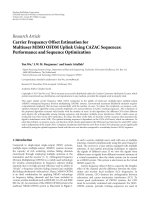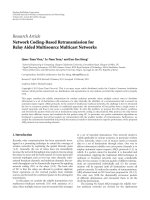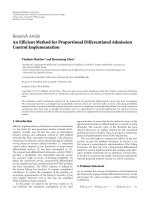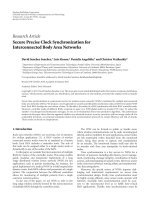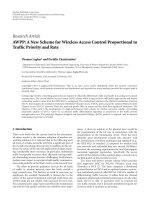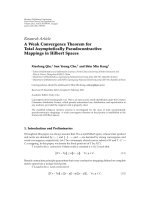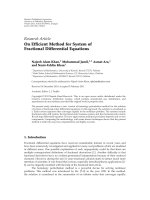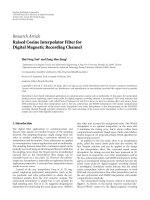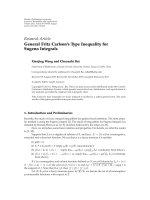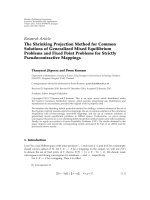Báo cáo hóa học: " Research Article General Viscosity Approximation Methods for Common Fixed Points of Nonexpansive Semigroups in Hilbert Spaces" ppt
Bạn đang xem bản rút gọn của tài liệu. Xem và tải ngay bản đầy đủ của tài liệu tại đây (511.53 KB, 12 trang )
Hindawi Publishing Corporation
Fixed Point Theory and Applications
Volume 2011, Article ID 783502, 12 pages
doi:10.1155/2011/783502
Research Article
General Viscosity Approximation Methods for
Common Fixed Points of Nonexpansive Semigroups
in Hilbert Spaces
Xue-song Li,
1
Nan-jing Huang,
1
and Jong Kyu Kim
2
1
Department of Mathematics, Sichuan University, Chengdu, Sichuan 610064, China
2
Department of Mathematics, Kyungnam University, Masan, Kyungnam 631-701, Republic of Korea
Correspondence should be addressed to Jong Kyu Kim,
Received 12 November 2010; Accepted 17 December 2010
Academic Editor: Jen Chih Yao
Copyright q 2011 Xue-song Li et al. This is an open access article distributed under the Creative
Commons Attribution License, which permits unrestricted use, distribution, and reproduction in
any medium, provided the original work is properly cited.
This paper is devoted to the strong convergence of two kinds of general viscosity iteration
processes for approximating common fixed points of a nonexpansive semigroup in Hilbert spaces.
The results presented in this paper improve and generalize some corresponding results in X. Li et
al., 2009, S. Li et al., 2009, and Marino and Xu, 2006.
1. Introduction
Let H be a real Hilbert space and A be a linear bounded operator on H. Throughout this
paper, we always assume that A is strongly positive; that is, there exists a constant
γ>0such
that
Ax, x
≥
γ
x
2
, ∀x ∈ H.
1.1
We recall that a mapping T : H → H is said to be contractive if there exists a constant
α ∈ 0, 1 such that Tx − Ty≤αx − y for all x, y ∈ H. T : H → H is said to be
i nonexpansive if
Tx − Ty
≤
x − y
, ∀x, y ∈ H; 1.2
2 Fixed Point Theory and Applications
ii L-Lipschitzian if there exists a constant L>0suchthat
Tx − Ty
≤ L
x − y
, ∀x, y ∈ H; 1.3
iii pseudocontractive if
Tx − Ty,x − y
≤
x − y
2
, ∀x, y ∈ H;
1.4
iv φ-strongly pseudocontractive if there exists a strictly increasing function φ :
0, ∞ → 0, ∞ with φ00suchthat
Tx − Ty,x − y
≤
x − y
2
− φ
x − y
x − y
, ∀x, y ∈ H.
1.5
It is obvious that pseudocontractive mapping is more general than φ-strongly pseudocon-
tractive mapping. If φrαr with 0 <α≤ 1, then φ-strongly pseudocontractive mapping
reduces to β-strongly pseudocontractive mapping with 1 − α β ∈ 0, 1,whichismore
general than contractive mapping.
A nonexpansive semigroup is a family
Γ :
{
T
s
: s ≥ 0
}
1.6
of self-mappings on H such that
1 T0I,whereI is the identity mapping on H;
2 Ts tx T
sTtx for all x ∈ H and s, t ≥ 0;
3 Ts is nonexpansive for each s ≥ 0;
4 for each x ∈ H, the mapping T·x from R
into H is continuous.
We denote by FΓ the common fixed points set of nonexpansive semigroup Γ,thatis,
F
Γ
s≥0
F
T
s
{
x ∈ H : T
s
x x for each s ≥ 0
}
.
1.7
In the sequel, we always assume that FΓ
/
∅.
In recent decades, many authors studied the convergence of iterative algorithms for
nonexpansive mappings, nonexpansive semigroup, and pseudocontractive semigroup in
Banach spaces see, e.g., 1–15.Letf : H → H be a contractive mapping with coefficient
α ∈ 0, 1, T : H → H be a nonexpansive mapping, and A be a strongly positive and linear
bounded operator with coefficient
γ>0. Let F denote the fixed points set of T. Recently,
Marino and Xu 6 considered the general viscosity approximation process as follows:
x
t
I − tA
Tx
t
tγf
x
t
, 1.8
Fixed Point Theory and Applications 3
where t ∈ 0, 1 such that t<A
−1
and 0 <γ<γ/α.MarinoandXu6 proved that the
sequence {x
t
} generated by 1.8 converges strongly as t → 0 to the unique solution of the
variational inequality
A − γf
x
∗
,x− x
∗
≥ 0, ∀x ∈ F, 1.9
which is the optimality condition for the minimization problem
min
x∈F
1
2
Ax, x
h
x
, 1.10
where h is a potential function for γf,thatis,h
xγfx for all x ∈ H.
Let Γ : {Ts : s ≥ 0} be a nonexpansive semigroup on H and f : H → H be a
contractive mapping with coefficient α ∈ 0, 1. Very recently, S. Li et al. 5 considered the
following general viscosity iteration process:
x
n
I − α
n
A
1
t
n
t
n
0
T
s
x
n
ds α
n
γf
x
n
, ∀n ≥ 1,
1.11
where {α
n
}⊂0, 1 and {t
n
} are two sequences satisfying certain conditions. S. Li et al. 5
claimed that the sequence {x
n
} generated by 1.11 converges strongly as t
n
→∞to x
∗
∈
FΓ which solves the following variational inequality:
A − γf
x
∗
,x− x
∗
≥ 0, ∀x ∈ F
Γ
. 1.12
More research work related to general viscosity iteration processes for nonexpansive
mapping and nonexpansive semigroup can be found see, e.g., 5, 6, 12.
An interesting work is to extend some results involving general viscosity approx-
imation processes for nonexpansive mapping, nonexpansive semigroup, and contractive
mapping to nonexpansive semigroup and φ-strongly pseudocontractive mapping pseu-
docontractive mapping, resp.. Motivated by the works mentioned above, in this paper,
on one hand we study the convergence of general implicit viscosity iteration process
1.11 constructed from the nonexpansive semigroup Γ : {Tt : t ≥ 0} and φ-strongly
pseudocontractive mapping pseudocontractive mapping, resp. in Hilbert spa ces. On the
other hand, we consider the convergence of the following general viscosity iteration process:
x
n
I − α
n
A
T
t
n
x
n
α
n
γf
x
n
, ∀n ≥ 1, 1.13
where α
n
∈ 0, 1, γ>0, Tt
n
∈ Γ and f is a φ-strongly pseudocontractive mapping
pseudocontractive mapping, resp.. The results presented in this paper improve and
generalize some corresponding results in 4–6.
4 Fixed Point Theory and Applications
2. Preliminaries
A mapping T with domain DT and range RT in H is said to be demiclosed at a point
p ∈ H if {x
n
} is a sequence in DT which converges weakly to x ∈ DT and {Tx
n
} converges
strongly to p,thenTx p.
For the sake of convenience, we restate the following lemmas that will be used.
Lemma 2.1 see 6. Let A be a strongly positive and linear bounded operator on a real Hilbert space
H with coefficient
γ>0 and 0 <ρ≤A
−1
.ThenI − ρA≤1 − ργ.
Lemma 2.2 see 16. Let E be a Banach space and T : E → E be a φ-strongly pseudocontractive
and continuous mapping. Then T has a unique fixed point in E.
Lemma 2.3 see 9. Let E be a uniformly convex Banach space, K a nonempty closed convex subset
of E and T : K → E a nonexpansive mapping. Then I − T is demiclosed at zero.
Lemma 2.4 see 10. Let C be a nonempty bounded closed convex subset of a real Hilbert space H
and Γ{Ts : s ≥ 0} be a nonexpansive semigroup on H. Then for any h ≥ 0,
lim
t →∞
sup
x∈C
1
t
t
0
T
s
xds − T
h
1
t
t
0
T
s
xds
0. 2.1
3. Main Results
We first discuss the convergence of general implicit viscosity iteration process 1.11
constructed from a nonexpansive semigroup Γ : {Ts : s ≥ 0}.
Theorem 3.1. Let Γ : {Ts : s ≥ 0} be a nonexpansive semigroup on H and f : H → H be an
L
f
-Lipschitzian φ-strongly pseudocontractive mapping with lim
t → ∞
φt∞.LetA be a strongly
positive and linear bounded operator on H with coefficient
γ. Then for any 0 <γ≤ γ, the sequence
{x
n
} generated by 1.11 is well defined. Suppose that
lim
t →∞
α
n
0, lim
n →∞
t
n
∞.
3.1
Then the sequence {x
n
} converges strongly as n →∞toacommonfixedpointx
∗
∈ FΓ that is the
unique solution in FΓ to variational inequality (VI):
γf
x
∗
− Ax
∗
,x
∗
− p
≥ 0, ∀p ∈ F
Γ
. 3.2
Proof. Since lim
n →∞
α
n
0, we may assume without loss of generality that α
n
< A
−1
,for
any n ≥ 1. Let us define a mapping T
n
: H → H provided by
T
n
x : α
n
γf
x
I − α
n
A
1
t
n
t
n
0
T
s
xds, ∀n ≥ 1.
3.3
Fixed Point Theory and Applications 5
An application of Lemma 2.1 yields that
T
n
x − T
n
y, x − y
I − α
n
A
1
t
n
t
n
0
T
s
x − T
s
y
ds, x − y
α
n
γ
f
x
− f
y
,x− y
≤
I − α
n
A
x − y
2
α
n
γ
x − y
2
− φ
x − y
x − y
≤
1 − α
n
γ − γ
x − y
2
− α
n
γφ
x − y
x − y
≤
x − y
2
− α
n
γφ
x − y
x − y
,
3.4
and thus T
n
is φ-strongly pseudocontractive and strongly continuous. It follows from
Lemma 2.2 that T
n
has a unique fixed point say x
n
∈ H,thatis,{x
n
} generated by 1.11 is
well defined.
Taking p ∈ FΓ,wehave
x
n
− p
2
α
n
γf
x
n
− Ap, x
n
− p
I − α
n
A
1
t
n
t
n
0
T
s
x
n
− p
ds, x
n
− p
≤ α
n
γf
x
n
− γf
p
,x
n
− p
α
n
γf
p
− Ap, x
n
− p
I − α
n
A
x
n
− p
2
≤
1 − α
n
γ − γ
x
n
− p
2
− α
n
γφ
x
n
− p
x
n
− p
α
n
γf
p
− Ap
x
n
− p
3.5
and so
γ − γ
x
n
− p
γφ
x
n
− p
≤
γf
p
− Ap
. 3.6
This implies that x
n
− p≤φ
−1
γfp − Ap/γ and {x
n
} is bounded.
We denote z
n
1/t
n
t
n
0
Tsx
n
ds and have z
n
− p≤x
n
− p,foranyp ∈ FΓ.
Since {x
n
} and {z
n
} are bounded, it follows from the Lipschitzian conditions of Γ and f that
{Az
n
} and {fx
n
} are two bounded sequences. Therefore,
x
n
− z
n
α
n
γf
x
n
− Az
n
−→ 0. 3.7
Let
C
x ∈ H :
x − p
≤ φ
−1
γf
p
− Ap
γ
. 3.8
Since t
n
→∞, C is a nonempty bounded closed convex subset and Ts-invariant i.e., TsC
is a subset of C, it follows from Lemma 2.4 that
lim
n →∞
z
n
− T
s
z
n
0, ∀s ≥ 0.
3.9
6 Fixed Point Theory and Applications
For each s ≥ 0, we know that
x
n
− T
s
x
n
≤
x
n
− z
n
z
n
− T
s
z
n
T
s
z
n
− T
s
x
n
≤ 2
x
n
− z
n
z
n
− T
s
z
n
.
3.10
Consequently, we have from formulas 3.7 and 3.9 that
lim
n →∞
x
n
− T
s
x
n
0, ∀s ≥ 0.
3.11
Because {x
n
} is bounded, there exists a subsequence {x
n
k
}⊂{x
n
} which converges weakly to
some x
∗
.ItisknownfromLemma 2.3 that I − Ts is demiclosed at zero for each s ≥ 0, where
I is the identity mapping on H.Thus,x
∗
∈ FΓ follows readily.
In addition, by 1.11 and Lemma 2.1, we observe
x
n
− x
∗
2
α
n
γf
x
n
− Ax
∗
,x
n
− x
∗
I − α
n
A
1
t
n
t
n
0
T
s
x
n
− x
∗
ds, x
n
− x
∗
≤ α
n
γf
x
n
− γf
x
∗
,x
n
− x
∗
α
n
γf
x
∗
− Ax
∗
,x
n
− x
∗
I − α
n
A
x
n
− x
∗
2
≤
1 − α
n
γ − γ
x
n
−x
∗
2
− α
n
γφ
x
n
−x
∗
x
n
−x
∗
α
n
γf
x
∗
− Ax
∗
,x
n
− x
∗
,
3.12
which implies that
γφ
x
n
− x
∗
x
n
− x
∗
≤
γf
x
∗
− Ax
∗
,x
n
− x
∗
. 3.13
This means that {x
n
k
} converges strongly to x
∗
. If there exists another subsequence {x
n
j
}⊂
{x
n
} which converges weakly to y
∗
,thenfrom3.11 and 3.13 we know that {x
n
j
} converges
strongly to y
∗
∈ FΓ.Foranyp ∈ FΓ, it follows from 1.11 that
Az
n
− γf
x
n
,x
n
− p
1
α
n
z
n
− x
n
,x
n
− p
1
α
n
1
t
n
t
n
0
T
s
x
n
− p
ds, x
n
− p
−
x
n
− p
2
≤ 0.
3.14
The convergence of sequences {x
n
k
} and {x
n
j
} yields that
Ax
∗
− γf
x
∗
,x
∗
− y
∗
≤ 0,
Ay
∗
− γf
y
∗
,y
∗
− x
∗
≤ 0.
3.15
Fixed Point Theory and Applications 7
Thus,
γ
x
∗
− y
∗
2
≤
A
x
∗
− y
∗
,x
∗
− y
∗
≤ γ
f
x
∗
− f
y
∗
,x
∗
− y
∗
≤ γ
x
∗
− y
∗
2
− γφ
x
∗
− y
∗
x
∗
− y
∗
.
3.16
This implies that x
∗
y
∗
. Therefore, {x
n
} converges strongly to x
∗
∈ FΓ.From3.14 and
the deduction above, we know that x
∗
is also the unique solution to VI 3.2. This completes
the proof.
Theorem 3.2. Let Γ : {Ts : s ≥ 0} be a nonexpansive semigroup on H and f : H → H be an
L
f
-Lipschitzian pseudocontractive mapping. Let A be a strongly positive and linear bounded operator
on H with coefficient
γ. Then for any 0 <γ<γ, the sequence {x
n
} generated by 1.11 is well defined.
Suppose that
lim
t →∞
α
n
0, lim
n →∞
t
n
∞.
3.17
Then the sequence {x
n
} converges strongly as n →∞toacommonfixedpointx
∗
∈ FΓ that is the
unique solution in FΓ to VI 3.2.
Proof. Similar to the proof of Theorem 3.1, we can verify that the sequence {x
n
} generated by
1.11 is well defined,
x
n
− p
≤
1
γ − γ
γf
p
− Ap
for a fixed p ∈ F
Γ
,
lim
n →∞
x
n
− T
s
x
n
0, ∀s ≥ 0.
3.18
Thus, {x
n
} is bounded and so there exists a subsequence {x
n
k
}⊂{x
n
} which converges
weakly to some x
∗
. It is obvious that x
∗
∈ FΓ.
In addition, by 1.11 and Lemma 2.1, we can show that
x
n
− x
∗
2
≤
1
γ − γ
γf
x
∗
− Ax
∗
,x
n
− x
∗
.
3.19
This means that {x
n
k
} converges strongly to x
∗
.Therestoftheproofisalmostthesameas
Theorem 3.1. This completes the proof.
Remark 3.3. 1 Theorems 3.1 and 3.2 improve and generalize Theorem 3.1 of 5 from
contractive mapping to φ-strongly pseudocontractive mapping and pseudocontractive
mapping, respectively. 2 Theorems 3.1 and 3.2 also improve and generalize Theorem 3.2 of
6 from nonexpansive mapping to nonexpansive semigroup, and from contractive mapping
to φ-strongly pseudocontractive mapping and pseudocontractive mapping, respectively.
A strong mean convergence theorem for nonexpansive mappings was first established
by Baillon 17, and later generalized to that for nonlinear semigroup see, e.g., 8.Itisclear
8 Fixed Point Theory and Applications
that Theorems 3.1 and 3.2 are valid for nonexpansive mappings. Thus, we have the following
mean ergodic assertions of general viscosity iteration process for nonexpansive mappings in
Hilbert spaces.
Corollary 3.4. Let H, f, A be as in Theorem 3 .1, T : H → H be a nonexpansive mapping such that
thefixedpointssetF of T is nonempty. Let {α
n
}⊂0, 1 be a real sequence such that lim
n →∞
α
n
0.
Then for any 0 <γ≤
γ, there exists a unique {x
n
} such that
x
n
I − α
n
A
1
n 1
n
j0
T
j
x
n
α
n
γf
x
n
, ∀n ≥ 0.
3.20
Moreover, the sequence {x
n
} generated by 3.20 converges strongly as n →∞toacommonfixed
point x
∗
∈ F that is the unique solution in F to variational inequality (VI):
γf
x
∗
− Ax
∗
,x
∗
− p
≥ 0, ∀ p ∈ F. 3.21
Corollary 3.5. Let H, f, A be as in Theorem 3 .2, T : H → H be a nonexpansive mapping such that
thefixedpointssetF of T is nonempty. Let {α
n
}⊂0, 1 be a real sequence such that lim
n →∞
α
n
0.
Then for any 0 <γ<
γ, there exists a unique {x
n
} satisfying 3.20. Moreover, the sequence {x
n
}
generated by 3.20 converges strongly as n →∞toacommonfixedpointx
∗
∈ F that is the unique
solution in F to VI 3.21.
We now turn to discuss the c onvergence of general implicit viscosity iteration process
1.13 constructed from a nonexpansive semigroup Γ : {Tt : t ≥ 0}.
Theorem 3.6. Let Γ : {Tt : t ≥ 0} be a nonexpansive semigroup on H and f : H → H be an
L
f
-Lipschitzian φ-strongly pseudocontractive mapping with lim
t → ∞
φt∞.LetA be a strongly
positive and linear bounded operator with coefficient
γ. Then for any 0 <γ≤ γ, the sequence {x
n
}
generated by 1.13 is well defined. Suppose that for any bounded subset K ⊂ H,
lim
s → 0
sup
x∈K
T
s
x − x
0,
3.22
lim
n →∞
t
n
lim
n →∞
α
n
t
n
0.
3.23
Then the sequence {x
n
} converges strongly as n →∞toacommonfixedpointx
∗
∈ FΓ that is the
unique solution in FΓ to VI 3.2.
Proof. Since lim
n →∞
α
n
0, we assume without loss of generality that α
n
< A
−1
,forany
n ≥ 1. Let
T
f
n
x : α
n
γf
x
I − α
n
A
T
t
n
x, ∀n ≥ 1 .
3.24
Fixed Point Theory and Applications 9
By Lemma 2.2,weknow
T
f
n
x − T
f
n
y, x − y
I − α
n
A
T
t
n
x − T
t
n
y
,x− y
α
n
γ
f
x
− f
y
,x− y
≤
I − α
n
A
x − y
2
α
n
γ
x − y
2
− φ
x − y
x − y
≤
x − y
2
− α
n
γφ
x − y
x − y
,
3.25
and thus T
f
n
is φ-strongly pseudocontractive and strongly continuous. It follows from
Lemma 2.2 that T
f
n
has a unique fixed point say x
n
∈ H,thatis,{x
n
} generated by 1.13 is
well defined.
Taking p ∈ FΓ,wenote
x
n
− p
2
α
n
γf
x
n
− Ap, x
n
− p
I − α
n
A
T
t
n
x
n
− p
,x
n
− p
≤ α
n
γf
x
n
− γf
p
,x
n
− p
α
n
γf
p
− Ap, x
n
− p
I − α
n
A
x
n
− p
2
≤
1 − α
n
γ − γ
x
n
− p
2
− α
n
γφ
x
n
− p
x
n
− p
α
n
γf
p
− Ap
x
n
− p
,
3.26
and so x
n
− p≤φ
−1
γfp − Ap/γ,thesequence{x
n
} is bounded. It follows from the
Lipschitzian conditions of Γ and f that {ATt
n
x
n
} and {fx
n
} are bounded. 1.13 implies
that
x
n
− T
t
n
x
n
α
n
γf
x
n
− AT
t
n
x
n
−→ 0. 3.27
For any given t>0,
x
n
− T
t
x
n
t/t
n
−1
k0
T
k 1
t
n
x
n
− T
kt
n
x
n
T
t
x
n
− T
t
t
n
t
n
x
n
≤
t
t
n
x
n
− T
t
n
x
n
T
t −
t
t
n
t
n
x
n
− x
n
≤ t
α
n
t
n
AT
t
n
x
n
− γf
x
n
max
{
T
s
x
n
− x
n
:0≤ s ≤ t
n
}
,
3.28
where t/t
n
is the integral part of t/t
n
. Since lim
n →∞
α
n
/t
n
0andT·x : R
→ H is
continuous for any x ∈ H, it follows from 3.22 that
lim
n →∞
x
n
− T
t
x
n
0 ∀ t ≥ 0.
3.29
Because {x
n
} is bounded, there exists a subsequence {x
n
k
}⊂{x
n
} which converges weakly
to some x
∗
.ByLemma 2.3, we know that x
∗
∈ FΓ.
10 Fixed Point Theory and Applications
In addition, by 1.13 and Lemma 2.1, we observe
x
n
− x
∗
2
α
n
γf
x
n
− Ax
∗
,x
n
− x
∗
I − α
n
A
T
t
n
x
n
− x
∗
,x
n
− x
∗
≤ α
n
γf
x
n
− γf
x
∗
,x
n
− x
∗
α
n
γf
x
∗
− Ax
∗
,x
n
− x
∗
I − α
n
A
x
n
− x
∗
2
≤
1 − α
n
γ − γ
x
n
− x
∗
2
− α
n
γφ
x
n
− x
∗
x
n
− x
∗
α
n
γf
x
∗
− Ax
∗
,x
n
− x
∗
,
3.30
which implies that
γφ
x
n
− x
∗
x
n
− x
∗
≤
γf
x
∗
− Ax
∗
,x
n
− x
∗
. 3.31
For any p ∈ FΓ, it follows from 1.13 that
AT
t
n
x
n
− γf
x
n
,x
n
− p
1
α
n
T
t
n
x
n
− x
n
,x
n
− p
1
α
n
T
t
n
x
n
− p, x
n
− p
−
x
n
− p
2
≤ 0.
3.32
TherestoftheproofisthesameasTheorem 3.1. This completes the proof.
To illustrate Theorem 3.6, we give the following example concerned with a nonexpan-
sive semigroup Γ : {Tt : t ≥ 0} on H.
Example 3.7. Let H be a Hilbert space. For each given t ≥ 0, let Tt : H → H be defined by
T
t
x e
−t
x, ∀x ∈ H. 3.33
Then it is easy to check that Γ : {Tt : t ≥ 0} is a nonexpansive semigroup satisfying 3.22
and FΓ is a singleton {θ},whereθ is the zero point in H.
Combining the proofs of Theorems 3.2 and 3.6, we can easily conclude the following
result.
Theorem 3.8. Let f : H → H be an L
f
-Lipschitzian pseudocontractive mapping and Γ : {Tt :
t ≥ 0} be a nonexpansive semigroup on H such that 3.22 holds. Let A be a strongly positive and
linear bounded operator with coefficient
γ. Then for any 0 <γ<γ , the sequence {x
n
} generated by
1.13 is well defined. Suppose that
lim
n →∞
t
n
lim
n →∞
α
n
t
n
0.
3.34
Fixed Point Theory and Applications 11
Then the sequence {x
n
} converges strongly as n →∞toacommonfixedpointx
∗
∈ FΓ that is the
unique solution in FΓ to VI 3.2.
Remark 3.9. 1 Theorems 3.6 and 3.8 improve and generalize Theorem 3.2 of 6 from
nonexpansive mapping to nonexpansive semigroup, and from contraction mapping to φ-
strongly pseudocontractive mapping and pseudocontractive mapping, respectively. 2 If A
is the identity mapping I, f,andΓ are restricted on a nonempty closed convex subset in H,
then Theorem 3.6 of 4 follows by Theorems 3.6 and 3.8.So,Theorems3.6 and 3.8 generalize
Theorem 3.6 of 4.
Acknowledgments
The authors are grateful to Professor J. C. Yao and the referees for valuable comments and
suggestions. This work was supported by The Key Program of NSFC Grant no. 70831005,
the National Natural Science Foundation of China 10671135, 11026063,andtheOpenFund
PLN0904 of State Key Laboratory of Oil and Gas Reservoir Geology and Exploitation
Southwest Petroleum University.
References
1 S S. Chang, “Viscosity approximation methods for a finite family of nonexpansive mappings in
Banach spaces,” Journal of Mathematical Analysis and Applications, vol. 323, no. 2, pp. 1402–1416, 2006.
2 R. Chen and H. He, “Viscosity approximation of common fixed points of nonexpansive semigroups
in Banach space,” Applied Mathematics Letters, vol. 20, no. 7, pp. 751–757, 2007.
3 J. S. Jung, “Viscosity approximation methods for a family of finite nonexpansive mappings i n Banach
spaces,” Nonlinear Analysis: Theory, Methods & Applications, vol. 64, no. 11, pp. 2536–2552, 2006.
4 X.Li,J.K.Kim,andN.Huang,“Viscosityapproximation of common fixed points for L-Lipschitzian
semigroup of pseudocontractive mappings in Banach spaces,” Journal of Inequalities and Applications,
vol. 2009, Article ID 936121, 16 pages, 2009.
5 S. Li, L. Li, and Y. Su, “General iterative methods for a one-parameter nonexpansive semigroup in
Hilbert space,” Nonlinear Analysis: Theory, Methods & Applications, vol. 70, no. 9, pp. 3065–3071, 2009.
6 G. Marino and H K. Xu, “A general iterative method for nonexpansive mappings in Hilbert s paces,”
Journal of Mathematical Analysis and Applications, vol. 318, no. 1 , pp. 43–52, 2006.
7 S. Reich, “Strong convergence theorems for resolvents of accretive operators in Banach spaces,”
Journal of Mathematical Analysis and Applications, vol. 75, no. 1 , pp. 287–292, 1980.
8 S. Reich, “A note on the mean ergodic theorem for nonlinear semigroups,” Journal of Mathematical
Analysis and Applications, vol. 91, no. 2, pp. 547–551, 1983.
9 N. Shahzad, “Approximating fixed points of non-self nonexpansive mappings in Banach spaces,”
Nonlinear Analysis: Theory, Methods & Applications, vol. 61, no. 6, pp. 1031–1039, 2005.
10 T. Shimizu and W. Takahashi, “Str ong convergence to common fixed points of families of
nonexpansive mappings,” Journal of Mathematical Analysis and Applications, vol. 211, no. 1, pp. 71–83,
1997.
11 Y. Song, R. Chen, and H. Zhou, “Viscosity approximation methods for nonexpansive mapping
sequences in Banach spaces,” Nonlinear Analysis: Theory, Methods & Applications, vol. 66, no. 5, pp.
1016–1024, 2007.
12 Y. Yao, Y C. Liou, and R. Chen, “A general iterative method for an infinite family of nonexpansive
mappings,” Nonlinear Analysis: Theory, Methods & Applications, vol. 69, no. 5-6, pp. 1644–1654, 2008.
13 H K. Xu, “Viscosity approximation methods for nonexpansive mappings,” Journal of Mathematical
Analysis and Applications, vol. 298, no. 1, pp. 279–291, 2004.
14 H K. Xu a nd R. G. Ori, “An implicit iteration process for nonexpansive mappings,” Numerical
Functional Analysis and Optimization, vol. 22, no. 5-6, pp. 767–773, 2001.
15 H. Zegeye, N. Shahzad, and T. Mekonen, “V iscosity approximation methods for pseudocontractive
mappings in Banach spaces,” Applied Mathematics and Computation, vol. 185, no. 1, pp. 538–546, 2007.
12 Fixed Point Theory and Applications
16 Z. Liu and S. M. Kang, “Convergence theorems for φ-strongly accretive and φ-hemicontractive
operators,” Journal of Mathematical Analysis and Applications, vol. 253, no. 1, pp. 35–49, 2001.
17 J B. Baillon, “Un th
´
eor
`
eme de type ergodique pour les contractions non lin
´
eaires dans un espace de
Hilbert,” ComptesRendusdel’Acad
´
emie des sciences, vol. 280, no. 22, pp. A1511–A1514, 1975.
